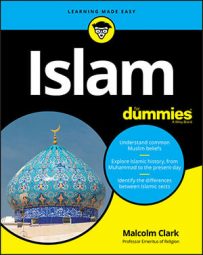Many Muslim children learn to read through the study of the Qur'an. When they grow up, they hear Qur'anic recitations over radio and television. Wherever they look, they see verses from the Qur'an written out in artistic style.
Educating using the Qur'an
Before the introduction of modern, state-run education systems that were based on a European model, formal education began with instruction in reading the Qur'an at about the age of 7. Today, this pattern of local Qur'anic schools for kids often continues alongside the state educational systems. And in Islamic countries, state schools incorporate religious education and Arabic into their curriculums. Remember that Arabic isn't the native language of most Muslim children.
In a typical example reported from a West African village, a group of young students gathers around the teacher with writing tablets, pen, ink, and copies of the Qur'an. The teacher begins with the first two verses of the Qur'an, teaching the name and pronunciation of each new letter as it occurs until all 28 letters have been learned. Then the student begins to combine the letters with the different vowels, using passages from Suras 105–111 in addition to Sura 1. Next the students combine the syllables to make words so that they can repeat the first two verses of Sura 1. So far, this is all reading and reciting of the Qur'an. Now the student learns to write. First he traces an outline of individual letters following the example given by the teacher. At each stage the teacher corrects him. By the time he has learned to read, recite, and write, he has covered about one-fourth of the Qur'an. The minority of students who persevere to the end (four years or longer) are able to recite and write the entire Qur'an. Such a major accomplishment is marked with a graduation ceremony and gifts to the student and the teacher.
Reciting the Qur'an
Recitation of the Qur'an (taliwa) is a highly honored performance art in Muslim countries that confers a blessing (baraka) on both the reciter and the listener. A person who memorizes the whole Qur'an can use the honorary title of hafiz, one who preserves the Qur'an in her heart.
In theory, any Muslim willing to invest the time and effort can memorize the Qur'an. To recite it in a beautiful manner, however, is an art form. In many Muslim countries, Qur'an recitation competitions are major events. Like a sports league or a spelling bee, winners at the local level move on to competition at a district level and then the national level. Such contests are especially well organized in Indonesia.
Some people obtain a professional rank as Qur'an reciters, performing at public and private events. They make CDs, and their recitations are broadcast on radio and television. Egyptian Qur'an reciters in particular have a high reputation and provide a model for others to emulate.
Reproducing the Qur'an: Calligraphy
Reproduction of the written Qur'an is as important as oral recitation of the Qur'an. Calligraphy is one of the two greatest art forms (along with architecture) of Islamic culture. Like professional recitation, calligraphy is a highly honored professional skill that requires years of practice to master. Only in China does calligraphy achieve the same perfection as in the Muslim world.
You can find two early calligraphic styles, although over time, many other scripts evolved:
- Kufic is the more boxy, angular, heavy, and formal script.
- Naskhi is the more elongated, rounded, cursive script.
Written verses from the Qur'an are used in many contexts:
- They adorn the walls of mosques and other religious buildings.
- The cloth covering of the Ka´ba, the sacred shrine of Islam in Mecca, has a band of Qur'anic verses near the top.
- Short verses with appropriate content are posted at the entrance to schools, hospitals, and other buildings.
- Certain suras and verses are inscribed to be used as a sort of good-luck charm to ward off illness and evil.
- Although frowned upon by conservative scholars, the practice persists in some places of writing a passage down, and then dissolving the ink from the page in a liquid solution that is swallowed as a healing potion.

